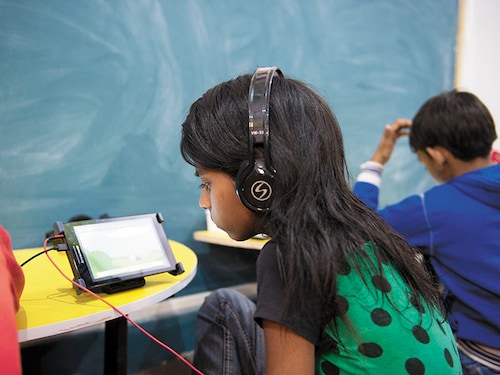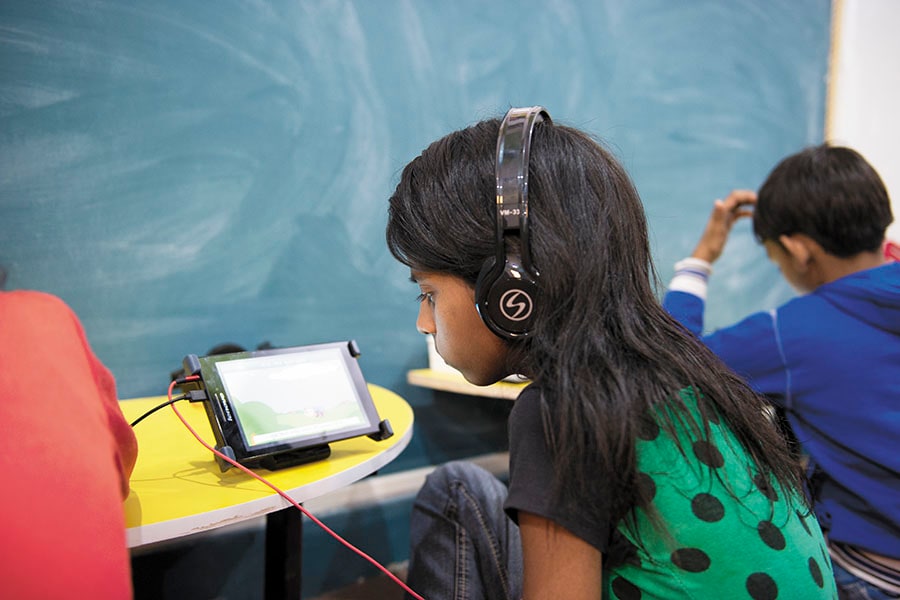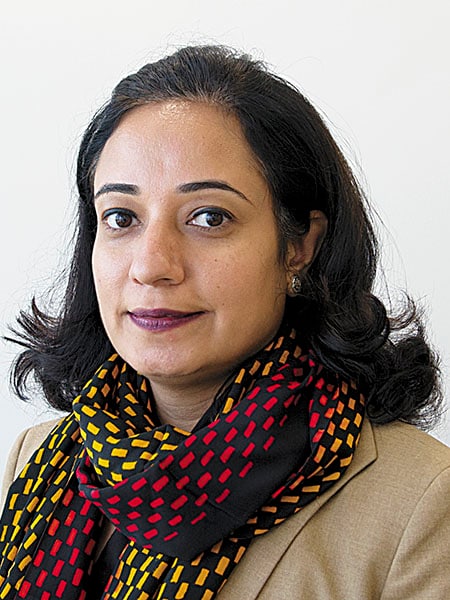Philanthropy and impact investing complement each other: Geeta Goel
The Michael & Susan Dell Foundation has used a combination of grants and investments in India to free children from the grip of urban poverty, says Geeta Goel



The Michael & Susan Dell Foundation had to expand its scope in India to include children who drop out of schools
Image: Amit Verma
Many sectors that facilitate social causes in India are at a nascent stage, hence philanthropy has a distinct role to play in complementing impact investments and creating a market that can attract commercial interests later, says Geeta Goel (43), director, mission investing at Michael & Susan Dell Foundation. The US-based foundation has been funding projects in India for a decade and has infused close to Rs 1,000 crore in the country through grants and equity in impact enterprises across sectors such as education, livelihood, microfinance etc. Edited excerpts from the interview:
Q. The Michael & Susan Dell Foundation has spent close to Rs 1,000 crore in India so far. What has been your learning in marrying the two worlds of social impact and profitable ventures?
We are the family foundation of Michael & Susan Dell set up in 1999 with the mission of impacting the lives of children living in urban poverty. We are a relatively young foundation globally and have embraced the principles of scale and sustainability embedded in the concept of venture philanthropy. We started funding projects in India in 2006 and, till now, have funded over 100 projects impacting over 7 million children and families. We have used a mix of grants, debt and equity to support projects that align with our mission and have tailored our funding tools with the ultimate objective of sustainability. The flexibility of using a suite of funding tools allows us to work with for-profit and non-profit organisations at an institutional as well as the industry/ecosystem level. It also helps us pilot innovative, impactful products and instill financial discipline for future scale. The focus on our mission helps us not to lose sight of social impact, and the focus on scale and sustainability ensures product viability and market linkages.
Q. How is the Indian market different from that of the US?
In the US, we focussed on two sectors—education and childhood health. When we entered India in 2006, we intuitively said we would target these two sectors, especially in view of our focus on urban-poor children. But on scanning the market, we realised the contours of urban poverty here are different from that of the US. In India, many children drop out of school. If we had to impact children, we needed to expand our work beyond schools. We needed to do something at the family level to improve income stability. In doing so, we had to be careful to not shift the focus from children. Moreover, a key differentiator in India in the context of impact investments is that foundations or trusts are not allowed to make investments if they intend to retain their tax exemption status. Even CSR [Corporate Social Responsibility], for that matter, cannot be an investment in for-profit activities. As a US private foundation, the law permits us to make investments in for-profit companies, provided the key objectives of the investment are to further our mission. These are termed as “programme-related investments”, where investors are required to comply with guidelines and documentations to establish that the main objective is not profit-maximisation.
Geeta Goel, director, mission investing, at Michael & Susan Dell FoundationQ. In India, the Michael & Susan Dell Foundation began its investments with microfinance companies. What is your view on the sector?
In 2006, when we were evaluating our options to improve the stability of household incomes, Bangladeshi social entrepreneur Muhammad Yunus won the Nobel Peace Prize for founding the Grameen Bank and pioneering the concept of microcredit. The sector received widespread attention, attracting talent and resources. However, in India, till that time, much of this inflow was in rural areas and less than 5 percent of microfinancing flowed into urban areas. In fact, that was the initial phase, when investors and lenders felt that the urban climate does not lend itself to microfinance in view of the migratory population in urban slums. But we decided to do some structured research and tap microfinance to bring economic stability to the lives of the urban poor at the household level.
Back then, we had two choices—do grants or equity investing. When we looked at microfinance, we realised the best funding tool is investing as the sector had proven itself to be financially viable and several rural microfinance institutions were transforming to for-profit structures. As equity investors, we wanted to instill financial discipline in the organisations from the early years. In 2009, we took our last MFI [microfinance institution] proposal to the board, acknowledging the success of urban microfinance. Our role as a catalyst in creating a market shift to urban areas was near completion. In fact, that was when we also started working on our education portfolio.
Q. The microfinance sector witnessed a crisis in 2010. Is that the reason you decided to not make any fresh investments later?
We decided to plunge into microfinance when it was absolutely new. We funded companies like Ujjivan, Janalakshmi, Swadhaar, Arohan, SONATA, Svasti and Samhita Social Ventures. We started exiting at a time when the market was created and there was enough investor money and entrepreneurs could attract commercial funds. Between 2011 and 2013, we exited Ujjivan and Janalakshmi as our role as philanthropic investors was over. These companies were now attracting commercial capital and had embedded a strong double bottom line—financial and social impact—in their DNA. We have made partial exits in Swadhaar and SONATA, and will be looking at completely exiting our microfinance portfolio over the next 24 months.
Q. Do you think impact investing in India is disrupting philanthropy?
Both are absolutely essential and, in a way, they complement each other because a lot of sectors in India that facilitate social causes are still at a nascent stage. Philanthropy is required in the beginning to create a market that can attract commercial interest later. Also, different pools of capital are required for different segments. For instance, in microfinance, the ‘investment model’ worked the best for us as it helped create financial discipline in entrepreneurs. In education, on the contrary, we started working with non-profits and supported them through grants as these organisations were working with government schools to improve learning levels of children. Some of our early grants were given to organisations like Naandi Foundation, Pratham, Bodh and Save the Children, among others.
However, over the years, we noticed two trends—children from our target segment started attending private, low-fee schools, and didn’t restrict their choice to government schools, and the government started working with for-profit companies also, and enrolled them as service providers and vendors, in the areas of pedagogy and teacher training, among others. Our target segment was being effectively served by both not-for-profits and for-profits. Hence, we expanded our funding in education from grants to include equity and debt products as well. Of course, our key objective was to create a visible change in the learning levels of a maximum number of children. So far, we have funded over 60 education projects including seven equity investments.
Q. Going forward, is there any other sector that you are keen to invest in?
Given that we are a foundation, we are focussed on programmes and then we decide on which tools to use. Education, livelihood and financial inclusion are our key areas. Our investments happen in these three areas and they complement the work that we do through our grants. The benefit of investments is that you get the customer to pay, so, in a way, it demands quality. In India, much of the low-income population is not dependant on government subsidies alone. They want to approach the private sector (read education and healthcare) for services. While in many other markets the bottom of the pyramid has become used to government subsidies, in India we have a thriving entrepreneurial market serving low-income customers, in the form of low fees, English medium schools, doctors’ clinics, (clean) water companies, and even skill training or placement companies. Apart from microfinance and education, since 2008-09, we have also started looking at other financial services and skill training. In fact, several of our skill training companies are aligned with the government’s Skill India initiative.
Q. How do you choose a startup for funding?
For us, the first filter in screening any investment is its social impact. Then, we evaluate the scalability and sustainability of the startup, is it a new idea and how well can it be executed. At an early stage of a company, significant emphasis is placed on the quality of the promoter or founder. We call it the test of ‘3 Ps’—passion, performance and patience.
First Published: Jan 18, 2017, 07:14
Subscribe Now